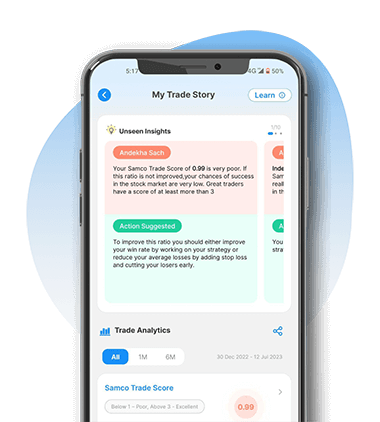
Open Ended and Close Ended Mutual Funds:
- In this Samco Investor Education Series, we will cover a topic of Open Ended and Close Ended Mutual Funds.
- In this article, we will cover in-depth information about what are these funds, benefits of investing in open ended and close ended funds, key differences between them, their characteristics, and a lot more which will be helpful for the investors to make informed investment decisions.
- Every year with diminishing returns on fixed deposits and slowdown in the real estate sector, more and more Indians are shifting their wealth in equity markets and mutual funds.
- Because of this immense domestic inflows, and increased participation of foreign investors in the Indian mutual fund industry, India's asset management industry has seen robust growth over the last few years.
- In India, mutual funds as a percentage of GDP are just 11 percent (equity 4 percent and debt 7 percent), while the world average is 62 percent.
- This shows that the mutual fund industry in India has still, a huge upside potential.
- Below is the brief summary & comparison between open ended and close ended mutual funds. Have a look.
Open Ended Mutual Fund:
- These funds buy and sell units on a continuous basis and, hence, allow investors to enter and exit as per their convenience.
- The units can be purchased and sold even after the initial offering (NFO) period (in case of new funds). The units are bought and sold at the net asset value (NAV) declared by the fund.
- An open-ended fund is not obliged to keep selling new units all the time.
- For instance, if the fund manager and management think they will not be able to manage such a huge corpus in the fund optimally, it can stop accepting new subscription requests from investors.
- The same thing happened to one of the fund of DSP Blackrock fund house.
- Fund manager of the DSP Blackrock Small Cap Fund decided to stop accepting new investments in the scheme from 2017 because it was becoming increasingly difficult to manage.
- Such a large investment inflow which they were receiving due to an exceptional performance by the scheme with more than 30% compounded returns annually in last 5 years as per the latest data from Moneycontrol.
- It continuously became difficult to deliver such high returns to the investors because of the huge fund size.
- So to sum up, open-ended funds may stop accepting fresh funds when they think they won't be able to manage the corpus with consistency in the performance.
- However, any open-ended fund has to repurchase the units at all times when the investor wants to redeem his funds.
Closed Ended Mutual Fund:
- In the case of a closed-ended fund, an investor can invest in the fund only at the time of NFO.
- After completion of NFO there is a lock-in period before which the investor cannot redeem his investments.
- However, the units of the closed-ended fund can be traded through the organized stock exchange anytime.
- The number of outstanding units of a closed-ended fund does not change as a result of trading on the stock exchange.
- Apart from listing on an exchange, these funds sometimes offer to buy back the units, thus offering another avenue for liquidity.
- As per data from the Association of Mutual Funds in India (Amfi), the total assets under management (AUM) for closed-end schemes at Rs 1.92 trillion (September 30, 2018) are around 9.5% of the AUM for open-ended schemes which is Rs. 20.07 trillion.
Key Differences:
1. Mode of transaction
Under open-ended funds, investors can buy or sell the units directly from mutual fund house whereas under closed-ended funds, after the closure of NFO, investors cannot trade units directly through fund house. But he can buy or sell the units from the organized stock exchange.
2. Buying and selling of units
Under open-ended mutual funds, the number of shares outstanding keeps changing all the time because of continuous selling and repurchasing of units by the fund house according to the request from the investors. After completion of New fund offer (NFO) which is like an IPO in the stock market where investors can subscribe to the issue for the first time, units of close-ended funds are traded on exchanges. In this manner, buying and selling units of closed-ended funds are almost the same as buying and selling stocks.
3. Redemption pressure
In case of open ended and close ended mutual funds, it becomes necessary for the fund manager to maintain liquidity and these assets may sometimes earn sub-optimal returns. It may compress the return of the fund. The redemption pressure can sometimes get critical at the time of extreme market turbulence. One of the advantages of the closed-ended fund is that the fund manager can take a long term view by investing in an asset that can generate good returns over the long term because they do not have redemption pressure in terms of market sell-off.
4. Liquidity
Open-ended fund units are highly liquid and can be bought and sold anytime subject to exit load. Closed-ended fund come with a lock-in period and units can be redeemed only after that period making it illiquid.
5. Changes in Unit Capital
Open-ended funds are required to sell or repurchase the units anytime at the request of the investor because of the frequent transactions. The unit capital of fund doesn’t stay same. In case of closed-ended funds, unit capital of fund stays the same after the completion of the NFO because number of the total outstanding units will remain the same irrespective of trading of those units on exchanges.
6. Requirement of a Demat account
To buy or sell the units of the open-ended fund through a fund house, an investor does not need to have a demat account. To trade the units of a closed ended fund after NFO, an investor needs to open a demat account and place trades through a broker or financial advisor.
7. Transaction charges
An investor buying or selling units through fund house need not pay any separate brokerage charges for open-ended funds. In case of closed-ended funds, an investor buying or selling the units through the stock exchange will likely pay a sales commission to a stock exchange broker at the time of the transaction.
8. Tax benefit
Investment in open-ended mutual fund gives no tax benefit in terms of deduction in total income. Investment in Equity linked saving scheme (ELSS) which is a type of closed-ended mutual fund gives tax benefit under section 80C up to Rs. 1,50,000.
9. Unit price
The price at which an investor buys or sells shares of an open end mutual fund is the NAV which is declared by the AMC at the closure of business day at 8 p.m. In case of closed-ended funds, the units may trade at a premium or discount to the NAV depending on the investors’ expectations of the fund’s future performance and prospects. For example, if many investors are willing to buy shares of a close ended fund and only a few units are available for sale, then an investor may be able to sell his units at a premium to the prevailing NAV.
Analysis of Performance in both schemes:
We have compared the best performing open ended and close ended funds as per the data of last 5 years.
Top performing open ended funds
| Fund Name | 1 year | 3 years CAGR | 5 years CAGR |
| L&T Midcap Fund | -1.9% | 14.7% | 28% |
| Kotak Emerging Equity Fund | -1.1% | 11.9% | 27.5% |
| ICICI Prudential Midcap Fund | 0.1% | 9.8% | 26.2% |
| DSP Blackrock Midcap Fund | -0.4% | 13.2% | 25.9% |
| HDFC Midcap Opportunities Fund | 0.3% | 12.2% | 25.7% |
Top performing close ended funds
| Fund Name | 1 year | 3 years CAGR | 5 years CAGR |
| Axis Long Term Equity Fund | 9.7% | 11.1% | 23.1% |
| ICICI Prudential R.I.G.H.T Fund | 9% | 12.3% | 22.5% |
| Aditya Birla Sunlife Tax Relief’96 Fund | 9.3% | 13.6% | 22.5% |
| Reliance Tax Saver | -8.2% | 8.7% | 21.4% |
| IDFC Tax Advantage Fund | 4.3% | 12.8% | 20.3% |
This covers the topic of open ended and close ended mutual funds with their comparison, benefits and performance. For more details about mutual funds, investment and market trading go to our investor education section or visit RankMF.com.
(Note: This content is for information purpose only. Avoid trading and investing based on the information given above. Before investing in stocks or mutual funds, please conduct proper due diligence).






Leave A Comment?